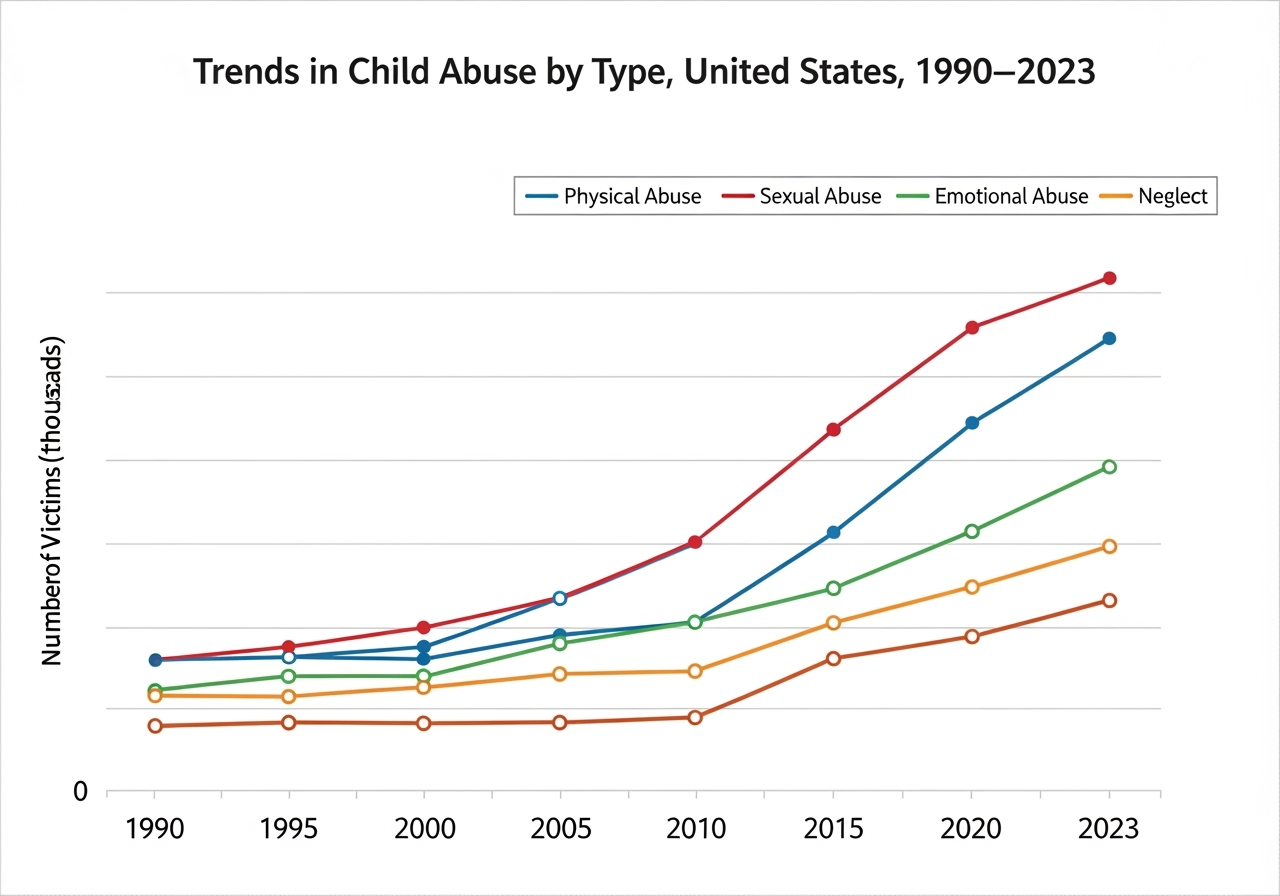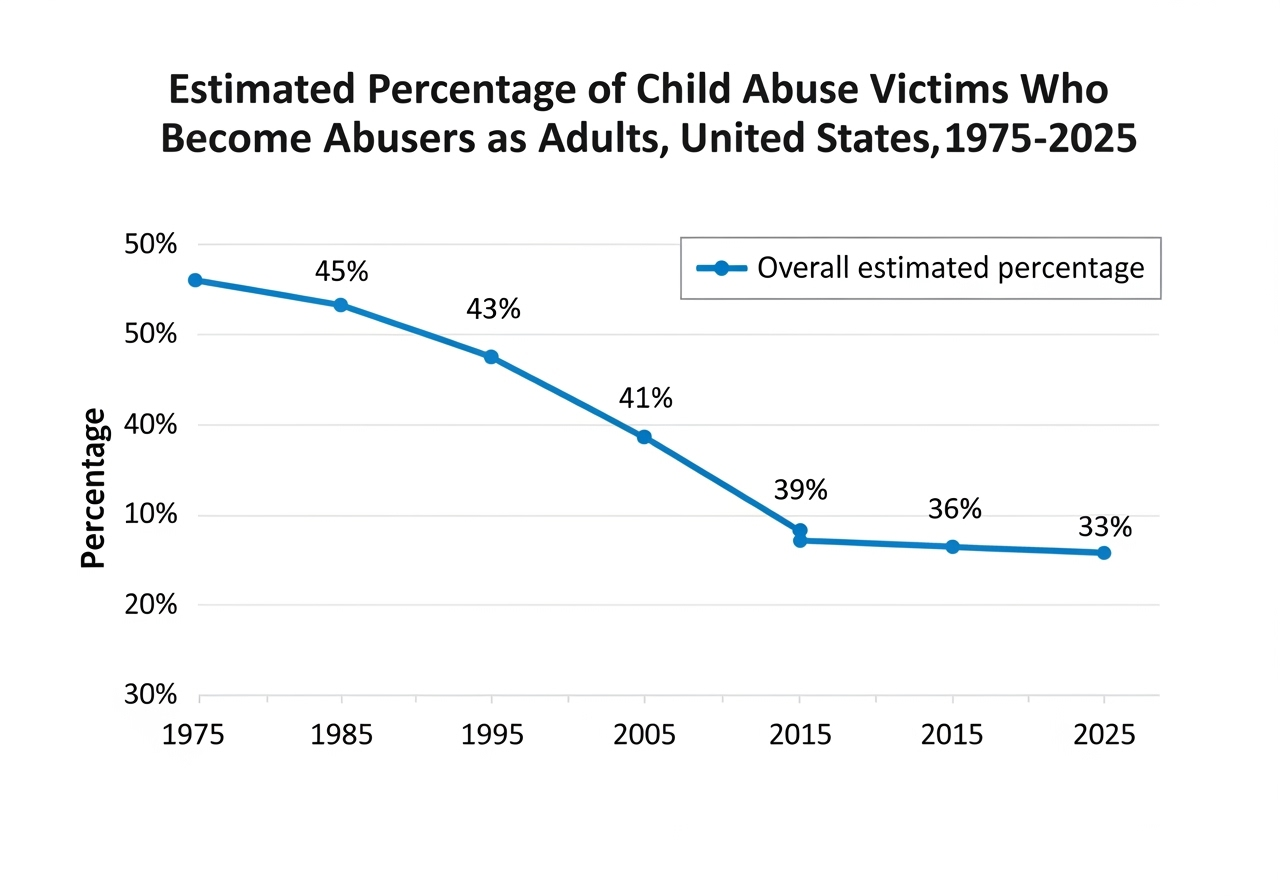Trends and Statistics in Child Abuse
50 years of identified victims
From 1980 through the mid-1990s, the number of children identified as victims of abuse and neglect in the United States rose from roughly 300,000 annual incidents to a peak near 900,000, before steadily declining to 558,899 by 2022, equivalent to about eight out of every 1,000 children. Throughout this period, stark racial disparities persisted: African-American children have consistently been overrepresented in substantiated cases. In 2022, African-American child fatalities from abuse and neglect stood at 6.37 per 100,000—more than three times the rate for white children (1.99 per 100,000) and nearly four times that of Hispanic children (1.68 per 100,000).
Children living in poverty have borne the brunt of maltreatment, with substantiation rates often more than four times higher than their more affluent peers. Data from the National Child Abuse and Neglect Data System show that kids in households below the federal poverty line experience confirmed abuse or neglect at rates exceeding 45 per 1,000, while children in non-impoverished families average fewer than 10 substantiations per 1,000. These economic disparities have remained remarkably consistent over the past four decades, underscoring how financial instability compounds risk factors for neglect, physical harm, and emotional maltreatment.
Generational transmission of abuse further entrenches these patterns: research archived by the National Data Archive on Child Abuse and Neglect indicates that between 30% and 50% of adults who suffered abuse or neglect in childhood go on to display maltreating behaviors toward their own children. This cycle of intergenerational trauma highlights the critical need for early, trauma-informed interventions and community-based supports aimed at both survivors and at-risk families to disrupt long-standing legacies of harm.
Over the past 30 years, victim laws in the United States have evolved significantly, reflecting a growing recognition of survivors’ rights and the unique needs of those affected by child abuse. In the early 1990s, most states had limited statutory protections for victims—reporting requirements existed, but survivors often faced barriers to justice, including short statutes of limitations and minimal rights during criminal proceedings. As awareness of the lifelong impacts of abuse grew, landmark legislation such as the Violence Against Women Act (1994) and the Victims of Crime Act (VOCA) expanded federal support for victims, established crime victim compensation funds, and set standards for victim notification and participation in the justice process. Many states also began to pass their own “Victims’ Bill of Rights,” granting survivors the right to be heard at sentencing, to receive information about their case, and to access support services.
In the 2000s and 2010s, advocacy led to further reforms, particularly around statutes of limitations for child sexual abuse. Research revealed that many survivors do not disclose their abuse until adulthood, prompting states to extend or eliminate time limits for filing civil and criminal cases. The Child Victims Act, passed in several states, created “look-back windows” allowing historic cases to be brought forward. Additionally, trauma-informed approaches have become more common in both the legal and social service systems, focusing on survivor safety, privacy, and empowerment. However, disparities persist—access to legal representation, culturally competent services, and consistent enforcement of victim rights still vary widely by state and community.
Despite this progress, further change is needed to ensure all child abuse survivors truly have a voice. Nationally, advocates call for the complete removal of statutes of limitations for all forms of child abuse, not just sexual abuse, so that survivors can seek justice on their own timeline. Comprehensive victim rights legislation should guarantee survivors’ participation at every stage of proceedings, access to trauma-informed legal and counseling support, and protection from retaliation or public exposure. Equally important is the need for survivor-led policy development, ensuring that those with lived experience shape the laws and systems that affect them. Only by centering survivors’ voices, removing barriers to justice, and investing in long-term support can the legal system fully honor the dignity and autonomy of all victims of child abuse.
30 years of law changes
Intergenerational Transmission of Child Abuse (1975 – 2025)
Over the last five decades, a major driver of this decline has been the significant increase in awareness and understanding of child abuse and its long-term effects. In the 1970s, child abuse was often minimized or misunderstood, with limited public discourse and few mandated reporting systems. As research illuminated the cycle of abuse and its impact on mental health, society began to shift—from silence and stigma to open dialogue and prevention. Public awareness campaigns, the introduction of child protective services, and the establishment of mandatory reporting laws empowered communities to recognize, report, and intervene in abuse cases much earlier, breaking generational patterns before they could take root.
Another key factor has been the expansion and professionalization of trauma-informed support services for survivors. Advances in psychology and social work have led to evidence-based therapies, peer support groups, and community-driven resources that help survivors process their trauma in healthy ways. Access to counseling, mentoring, and educational programs—often offered by nonprofits and advocacy organizations—has given survivors tools to heal, build resilience, and develop positive parenting skills. These interventions are crucial in disrupting the learned behaviors and emotional wounds that can otherwise perpetuate abuse cycles within families and communities.
Finally, evolving social norms and stronger legal protections have played a pivotal role. Over time, society has become less tolerant of abuse and more supportive of survivors’ rights. Legislative reforms have increased penalties for abusers, improved victim protection, and provided more robust support for at-risk families. The rise of survivor advocacy, including the voices of those with lived experience, has also contributed to policy changes and a broader cultural shift toward empathy, accountability, and prevention. Collectively, these changes have fostered an environment where survivors are more likely to seek help and less likely to repeat harmful patterns, resulting in the steady decline reflected in national statistics.
United States:
Adult Survivors of Child Abuse & Neglect
Prevalence Estimates (Nationwide)
General Prevalence:
CDC (2023): Approximately 1 in 7 children in the U.S. have experienced child abuse or neglect in the past year (reported and unreported).
Long-term impact: Studies estimate 1 in 4 adults (25%) report experiencing some form of abuse or neglect before age 18.
Total Adult Survivors:
With a U.S. adult population of about 260 million (2025 est.), this equates to roughly 65 million adult survivors nationwide.
Age Group Breakdown (U.S.)
While specific, up-to-date breakdowns by age are limited, surveys and retrospective studies provide estimates:
Age GroupEstimated % Reporting Childhood Abuse/NeglectEstimated # of Survivors (2025)18–29 years28%~13.7 million30–44 years26%~17.2 million45–64 years24%~20.8 million65+ years18%~13.5 million
Source: CDC, National Survey of Children’s Exposure to Violence, National Intimate Partner and Sexual Violence Survey, and peer-reviewed studies (2021–2024).
Prevalence Estimates (Statewide)
General Prevalence:
Ohio mirrors national trends, with 22–27% of adults reporting childhood abuse or neglect.
Adult Population (Ohio, 2025 est.): ~9.2 million
Estimated Adult Survivors:
2.0–2.5 million adults in Ohio are likely survivors of childhood abuse or neglect.
Age Group Breakdown (Ohio)
State-level age breakdowns are less granular, but applying national proportions to Ohio’s adult population yields:
Age GroupEstimated % Reporting Childhood Abuse/NeglectEstimated # of Survivors (Ohio, 2025)
18–29 years28%~450,00030–44 years26%~600,00045–64 years24%~900,00065+ years18%~550,000
Ohio:
Adult Survivors of Child Abuse & Neglect
Key Notes & Trends
Cycle Breaking: The percentage of child abuse victims who go on to become abusers is trending downward (from 45% in 1975 to a projected 33% in 2025), showing progress in prevention and intervention.
Underreporting: Actual numbers may be higher; many survivors do not disclose their experiences until adulthood, if ever.
Demographic Variations: Rates of reported abuse can vary by gender, ethnicity, and socioeconomic status, but prevalence is consistently high across all groups.
Sources
Centers for Disease Control and Prevention (CDC)
U.S. Department of Health & Human Services (Child Maltreatment Reports)
National Survey of Children’s Exposure to Violence
Ohio Department of Health
Peer-reviewed journals (2021–2024)



